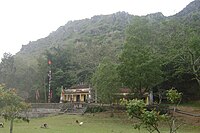|
The Legend of Mai An Tiêm The Legend of Mai An Tiêm (Vietnamese: Truyền thuyết Mai An Tiêm) or the Origin Tale of Watermelons (Vietnamese: Sự tích quả dưa hấu) is a Vietnamese folktale and myth, first told in Lĩnh Nam chích quái. It narrates the life of Mai An Tiêm, a culture hero living in the Hùng king's era and his discovery of watermelons for the Vietnamese people. StoryThe legend of Mai An Tiêm was the eight tale told in Lĩnh Nam chích quái,[1] a semi-fictional collection written in the fourteenth century, under the title Tây Qua Truyện (chữ Hán: 西瓜傳; literally 'The Tale of the Western Fruit').
More recent variants of the story have Mai An Tiêm exiled to a desert island, where he carved his name onto the watermelons and threw them into the sea to be picked up by fishermen.[2] They also emphasize more on Tiêm's resourcefulness and less on his religious belief.[3][4] AdaptionsThe legend from Lĩnh Nam chích quái was novelized as Quả Dưa Đỏ (lit. 'The Red Melon') by Nguyễn Trọng Thuật and published Nam Phong Magazine in 1925, which was one of the first modern Vietnamese novels.[5] The novel was also inspired by Robinson Crusoe.[6] In 2011, Tô Hoài wrote the novel Đảo Hoang (lit. 'The Desert Island') based on the legend.[7] The tale of watermelons is also one of Vietnamese fairy tales adapted by Cổ tích Việt Nam (lit. 'Vietnamese fairy tales'), a VHS series directed by Nguyễn Minh Chung.[8] The episode was released in 1995, starring Quang Hải as Mai An Tiêm.[9] LegacyAdorationA street in Nha Trang, Khánh Hòa is named after Mai An Tiêm.[10] Temple and Festival The desert island where Mai An Tiem was banished to is believed to be in Nga Phú commune, Nga Sơn District in Thanh Hóa, now completely inland. In this commune, there is a temple of Mai An Tiêm, where an annual festival is held to commemorate him from March 12 to March 15 in the Vietnamese calendar.[11][12] The temple is recognized as a provincial cultural and historical relic site by Thanh Hóa government.[13] StampsThe tale of Mai An Tiêm is featured on a four-stamp set issued by Vietnam Post on June 1, 2021. The stamp set is designed by artist Tô Minh Trang, with professor Đoàn Thị Tình and the Institute of History as advisors.[14] InterpretationThe main interpretation of the tale is that it upholds the value of hard work and labor, as well as the indomitable will and resourcefulness of local people.[15][16][17] References
|